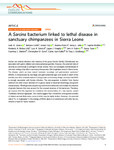A Sarcina bacterium linked to lethal disease in sanctuary chimpanzees in Sierra Leone
Owens, Leah A.
Colitti, Barbara
Hirji, Ismail
Pizarro, Andrea
Jaffe, Jenny E.
Moittié, Sophie
Bishop-Lilly, Kimberly A.
Estrella, Luis A.
Voegtly, Logan J.
Kuhn, Jens H.
Suen, Garret
Deblois, Courtney L.
Dunn, Christopher D.
Juan-Sallés, Carles
Goldberg, Tony L.
Human and animal infections with bacteria of the genus Sarcina (family Clostridiaceae) are associated with gastric dilation and emphysematous gastritis. However, the potential roles of sarcinae as commensals or pathogens remain unclear. Here, we investigate a lethal disease of unknown etiology that affects sanctuary chimpanzees (Pan troglodytes verus) in Sierra Leone. The disease, which we have named “epizootic neurologic and gastroenteric syndrome” (ENGS), is characterized by neurologic and gastrointestinal signs and results in death of the animals, even after medical treatment. Using a case-control study design, we show that ENGS is strongly associated with Sarcina infection. The microorganism is distinct from Sarcina ventriculi and other known members of its genus, based on bacterial morphology and growth characteristics. Whole-genome sequencing confirms this distinction and reveals the presence of genetic features that may account for the unusual virulence of the bacterium. Therefore, we propose that this organism be considered the representative of a new species, named “Candidatus Sarcina troglodytae”. Our results suggest that a heretofore unrecognized complex of related sarcinae likely exists, some of which may be highly virulent. However, the potential role of “Ca. S. troglodytae” in the etiology of ENGS, alone or in combination with other factors, remains a topic for future research.
Dateien zu dieser Publikation

